Modeling of a special physical phenomenon results into the f
Solution
Part has been embedded in main matlab file.
Save the files as separate M files in same folder to run
MAIN FILE
clear all
clc
%%
A=[-2,1,0,0,0;1,-2,1,0,0;0,1,-2,1,0;0,0,1,-2,1;0,0,0,1,-2];
b=[12;24;36;48;38];
B=inv(A);
%% a.
% row norm
s1=max(sum(abs(A),2)); % sum along rows of A
s2=max(sum(abs(B),2)); % sum along rows of inv(A)
condition_number_row_sum_norm=s1*s2
% coloumn sum norm
s1=max(sum(abs(A),1)); % sum along rows of A
s2=max(sum(abs(B),1)); % sum along rows of inv(A)
condition_number_column_sum_norm=s1*s2
% Frobenius norm
s1=sqrt(sumsqr(A)); % sum along rows of A
s2=sqrt(sumsqr(B)); % sum along rows of inv(A)
condition_number_Frobenius_sum_norm=s1*s2
%% b.
X1=NaiveGaussElim(A,b);
X2=GaussElim(A,b);
X3=Ludecomp(A,b);
X4=A\\b;
%% c.
X5=inverse_gauss(A)*b;
%% d.
X6=LU_inv(A)*b;
function x = NaiveGaussElim(A,b);
n = length(b); x = zeros(n,1);
for k=1:n-1 % forward elimination
for i=k+1:n
xmult = A(i,k)/A(k,k);
for j=k+1:n
A(i,j) = A(i,j)-xmult*A(k,j);
end
b(i) = b(i)-xmult*b(k);
end
end
% back substitution
x(n) = b(n)/A(n,n);
for i=n-1:-1:1
sum = b(i);
for j=i+1:n
sum = sum-A(i,j)*x(j);
end
x(i) = sum/A(i,i);
end
function x = GaussElim(A,b)
%GaussPP(A,b) solves the n-by-n linear system of equations using partial
%pivoting
%A is the coeficient matrix
%b the right-hand column vector
n = size(A,1); %getting n
A = [A,b]; %produces the augmented matrix
%elimination process starts
for i = 1:n-1
p = i;
%comparison to select the pivot
for j = i+1:n
if abs(A(j,i)) > abs(A(i,i))
U = A(i,:);
A(i,:) = A(j,:);
A(j,:) = U;
end
end
%cheking for nullity of the pivots
while A(p,i)== 0 && p <= n
p = p+1;
end
if p == n+1
disp(\'No unique solution\');
break
else
if p ~= i
T = A(i,:);
A(i,:) = A(p,:);
A(p,:) = T;
end
end
for j = i+1:n
m = A(j,i)/A(i,i);
for k = i+1:n+1
A(j,k) = A(j,k) - m*A(i,k);
end
end
end
%checking for nonzero of last entry
if A(n,n) == 0
disp(\'There is no unique solution\');
return
end
%backward substitution
x(n) = A(n,n+1)/A(n,n);
for i = n - 1:-1:1
sumax = 0;
for j = i+1:n
sumax = sumax + A(i,j)*x(j);
end
x(i) = (A(i,n+1) - sumax)/A(i,i);
end
function x =Ludecomp(A,b)
% LU factorization of an n by n matrix A
n=size(A);
[L,U,P]=LU_factor(A);
y=L\\b;
x=U\\y;
end
function [L,U,P] = LU_factor(A)
% LU factorization.
%
%
% [L,U,P] = Lu(A) returns unit lower triangular matrix L, upper
% triangular matrix U, and permutation matrix P so that P*A = L*U.
%
s=length(A);
U=A;
L=zeros(s,s);
PV=(0:s-1)\';
for j=1:s,
% Pivot Voting (Max value in this column first)
[~,ind]=max(abs(U(j:s,j)));
ind=ind+(j-1);
t=PV(j); PV(j)=PV(ind); PV(ind)=t;
t=L(j,1:j-1); L(j,1:j-1)=L(ind,1:j-1); L(ind,1:j-1)=t;
t=U(j,j:end); U(j,j:end)=U(ind,j:end); U(ind,j:end)=t;
% LU
L(j,j)=1;
for i=(1+j):size(U,1)
c= U(i,j)/U(j,j);
U(i,j:s)=U(i,j:s)-U(j,j:s)*c;
L(i,j)=c;
end
end
P=zeros(s,s);
P(PV(:)*s+(1:s)\')=1;
function [Inverse] = inverse_gauss(A)
[m,n] = size(A);
if (m ~= n)
display(\'Matrix must be square for this program\')
return
else
end
x = 1; % iterator for elimination matrix 3rd dimension
for j = 1:1:n-1,
for i = j+1:1:m,
E(:,:,x) = eye(n);
E(i,j,x) = -A(i,j) / A(j,j);
A = E(:,:,x) * A;
x = x + 1;
end
end
x = 1;
for j = n:-1:2,
for i = j-1:-1:1,
P(:,:,x) = eye(n);
P(i,j,x) = -A(i,j) / A(j,j);
A = P(:,:,x) * A;
x = x + 1;
end
end
for i = 1:1:n,
S(:,:,i) = eye(n);
S(i,i,i) = 1 / A(i,i);
A = S(:,:,i) * A;
end
ProdE = 1;
[~,~,c] = size(E);
for ii = c:-1:1,
ProdE = ProdE * E(:,:,ii);
end
ProdP = 1;
[~,~,c] = size(P);
for ii = c:-1:1,
ProdP = ProdP * P(:,:,ii);
end
ProdS = 1;
[~,~,d] = size(S);
for jj = d:-1:1,
ProdS = ProdS * S(:,:,jj);
end
Inverse = ProdS*ProdP*ProdE;
end
function Ainv = LU_inv(A)
% LU factorization of an n by n matrix A
[L,U,P] = LU_factor(A);
% Solve linear system for Identity matrix
I=eye(size(A));
s=size(A,1);
Ainv=zeros(size(A));
for i=1:s
b=I(:,i);
Ainv(:,i)=TriangleBackwardSub(U,TriangleForwardSub(L,P*b));
end
function C=TriangleForwardSub(L,b)
% Triangle Matrix Forward Substitution
s=length(b);
C=zeros(s,1);
C(1)=b(1)/L(1,1);
for j=2:s
C(j)=(b(j) -sum(L(j,1:j-1)\'.*C(1:j-1)))/L(j,j);
end
function C=TriangleBackwardSub(U,b)
% Triangle Matrix Backward Substitution
s=length(b);
C=zeros(s,1);
C(s)=b(s)/U(s,s);
for j=(s-1):-1:1
C(j)=(b(j) -sum(U(j,j+1:end)\'.*C(j+1:end)))/U(j,j);
end
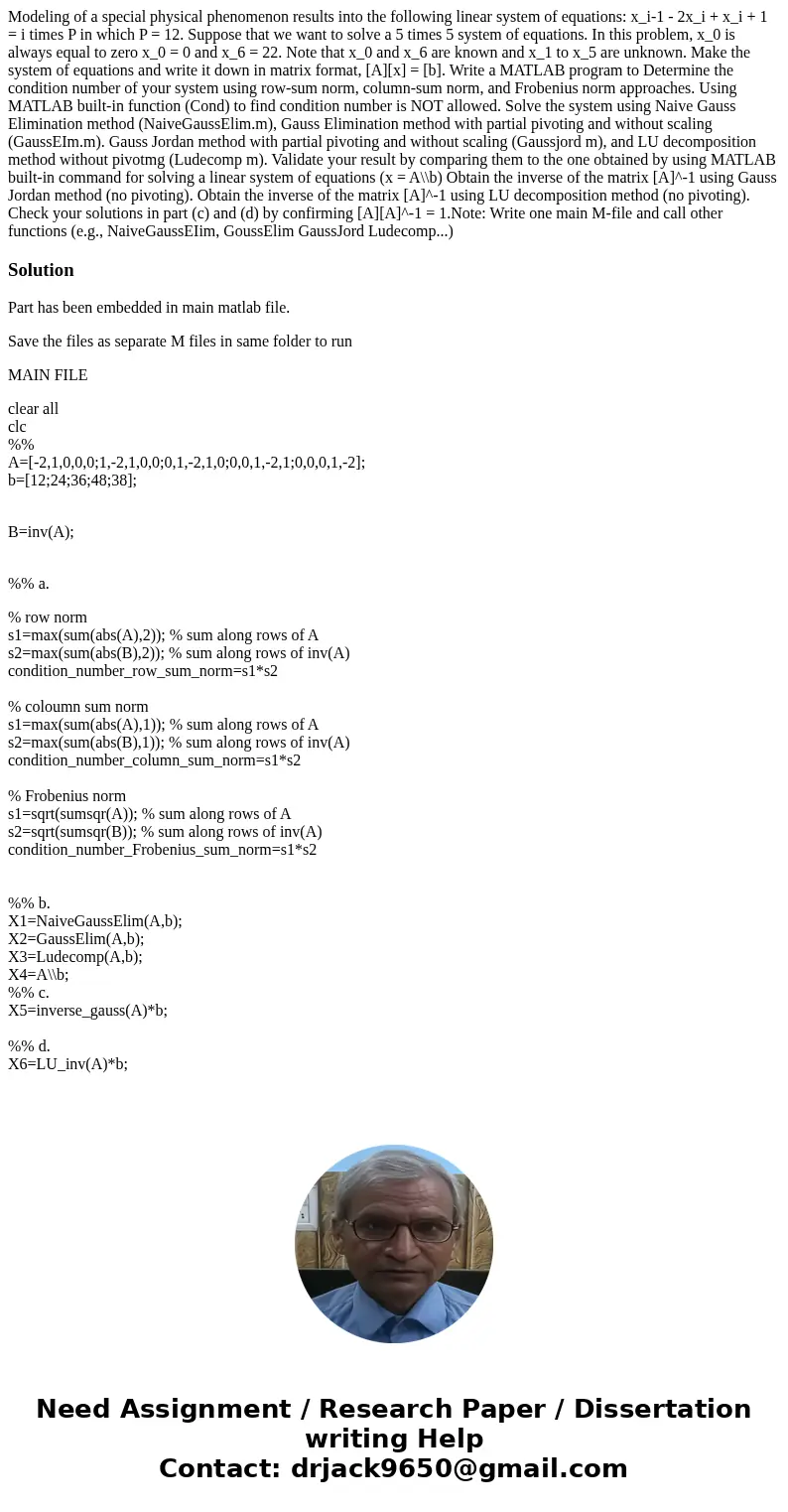
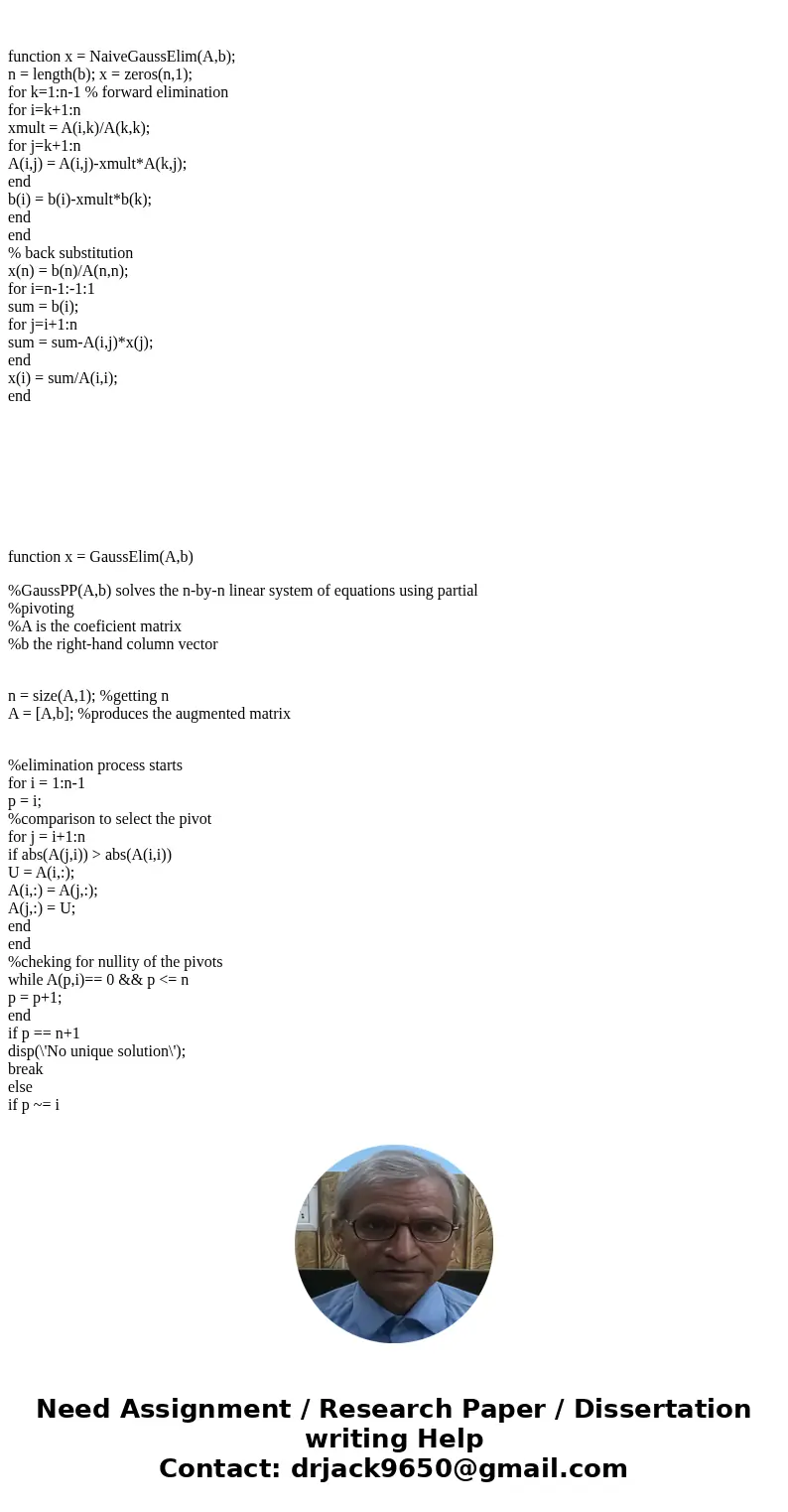
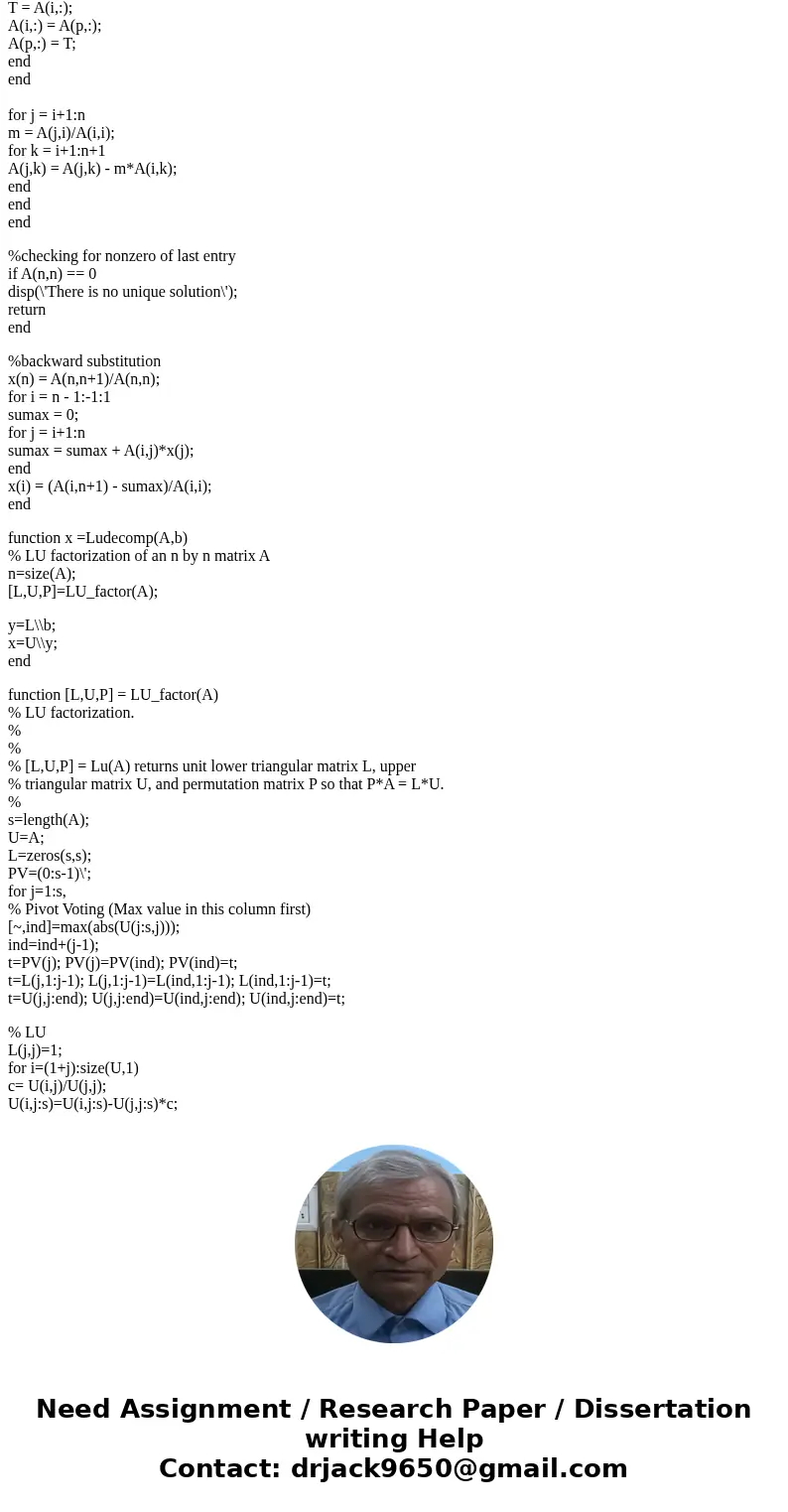
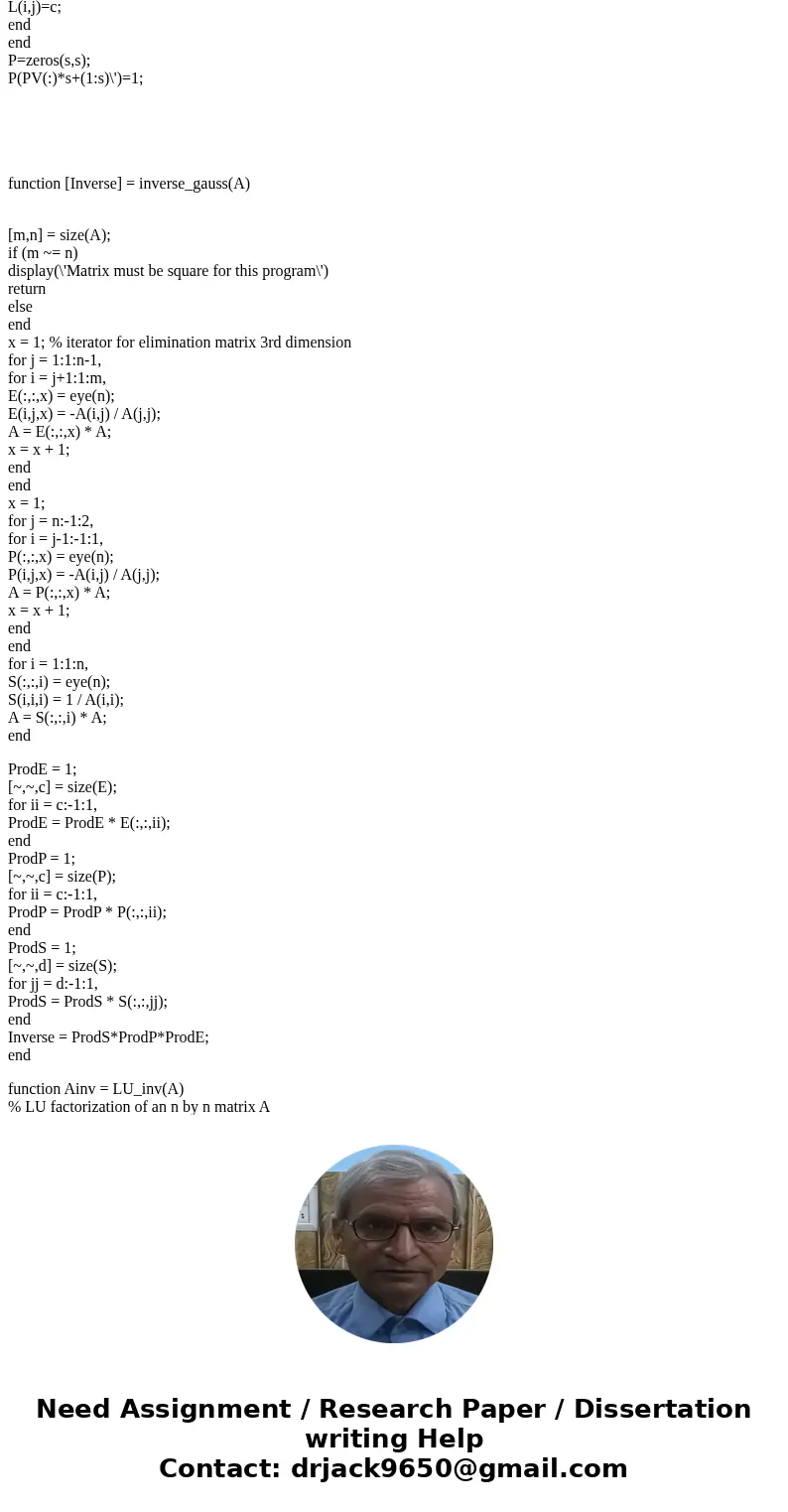
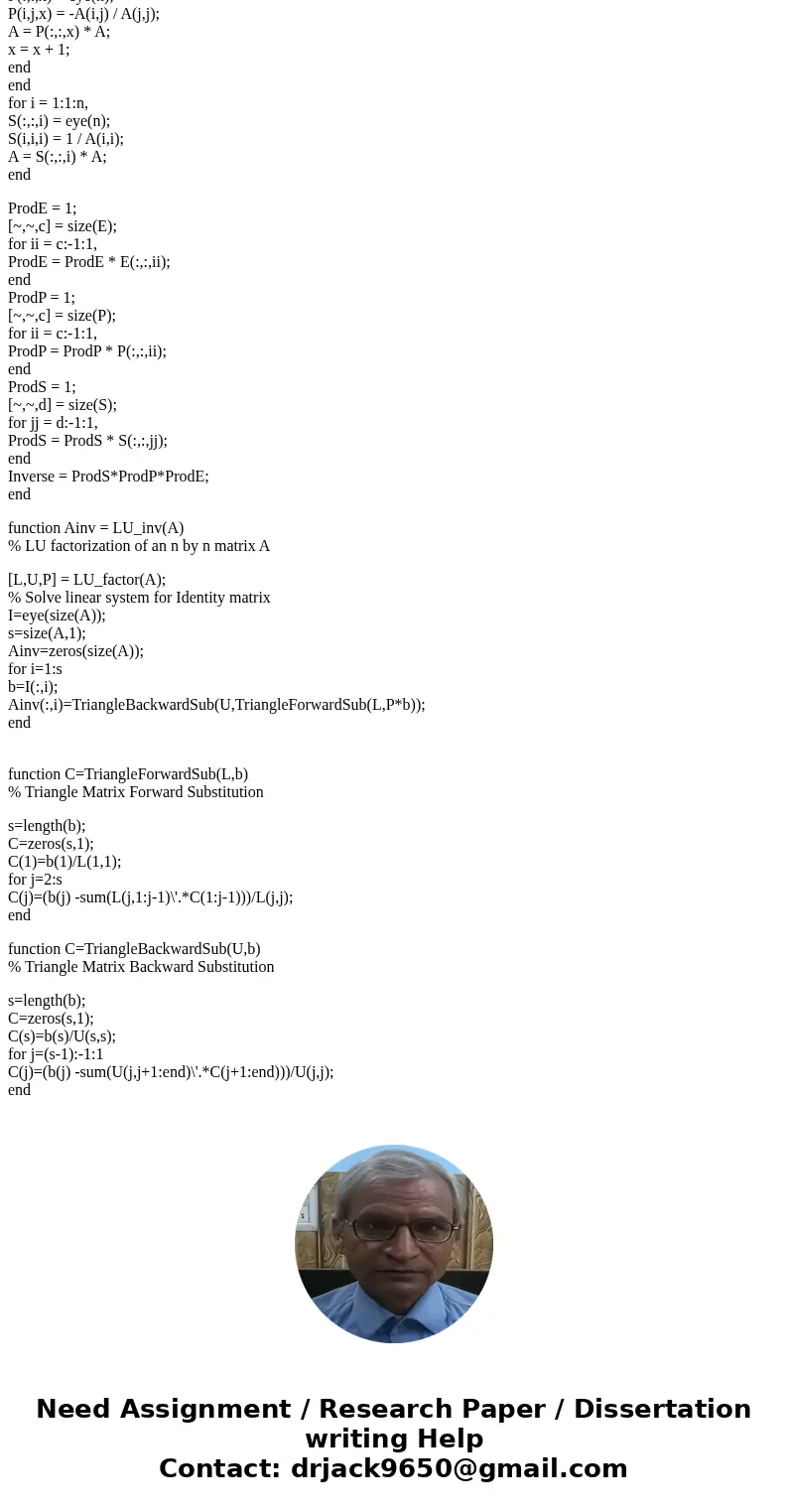
 Homework Sourse
Homework Sourse